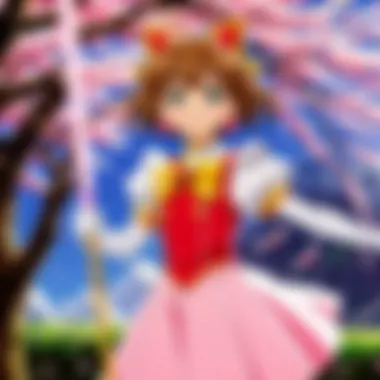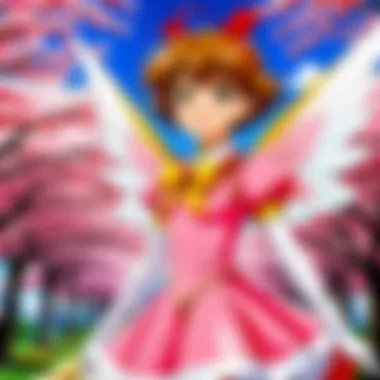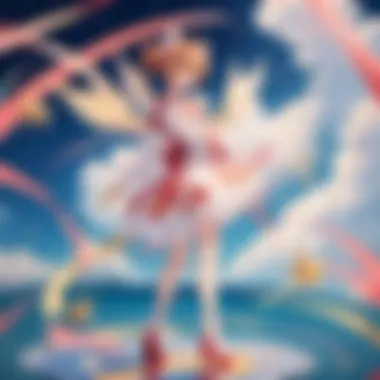A Detailed Look at Cardcaptor Sakura Movies


Prolusion to the Series
Cardcaptor Sakura is a pivotal entry in the realm of anime and manga, released in the late 1990s. The series began as a manga, illustrated by the esteemed group CLAMP, and then successfully transitioned into an anime adaptation. Its genre is primarily shoujo, characterized by its focus on appealing to a young female audience. The original manga was published from 1996 to 2000, while the anime aired from 1998 to 2000, encompassing 70 episodes and capturing the hearts of viewers.
The narrative follows Sakura Kinomoto, an elementary school girl who accidentally releases a set of magical cards known as Clow Cards from a mysterious book. With the guidance of the guardian, Keroberos, she embarks on a quest to retrieve these cards, facing various challenges and encounters in the process. The show artfully weaves themes of friendship, bravery, and personal growth into its storytelling.
The popularity of Cardcaptor Sakura has been phenomenal. It quickly gained a dedicated fanbase during its initial release. Many fans appreciate its rich artwork and the depth of its characters, contributing to its lasting legacy. Today, it is often regarded as a classic, having won various awards and accolades within the anime community. The series has not only inspired sequels and spin-offs but has also influenced many aspects of pop culture.
> "Cardcaptor Sakura not only captivated its audience with enchanting narratives but also resonated through its universal themes of growth and friendship."
The animated adaptations of Cardcaptor Sakura, particularly the movies, serve as critical extensions of the original story. Each film provides its own narrative arc while expanding the beloved universe. This analysis aims to investigate the films' unique contributions to storytelling, character development, and thematic explorations.
Prelims to Cardcaptor Sakura Movies
The world of anime has expansive narratives and rich characters, which play crucial role in captivating its audience. Cardcaptor Sakura holds a prominent place within this realm. This segment sets the stage for a detailed exploration of the movies associated with this celebrated franchise.
Overview of the Franchise
Cardcaptor Sakura is not merely a collection of stories; it represents a phenomenon in anime. Initially airing as a television series in 1998, it quickly became a favorite among fans. The franchise showcases the journey of Sakura Kinomoto, a young girl who accidentally releases magical cards that contain powerful spirits. She then embarks on a quest to capture these cards, experiencing growth and adventure along the way. Historically, the franchise began as a manga created by CLAMP. The subsequent anime adaptation expanded its reach. The movies, in particular, provide fans with extended narratives and deeper insights into characters.
The significance of the film adaptations lies in their ability to enhance Sakura's narrative. Each film provides new story arcs and experiences that explore her character in diverse situations. Fans of the series find these explorations beneficial, as they offer a richer context to Sakura's development and relationships. In summary, Cardcaptor Sakura movies transcend simple adaptations. They invite audiences to immerse themselves in a broader universe.
Historical Context of the Series
To understand the impact of the Cardcaptor Sakura films, one must first acknowledge the historical context of the anime. Emerging in the late 1990s, anime began capturing international attention. Cardcaptor Sakura played a part in this wave, combining magic, friendship, and personal growth.
The historical backdrop includes notable trends in animation and storytelling during the time of its release. The late 90s saw a rise in magical girl anime, showcasing young heroines with fantastical abilities. Cardcaptor Sakura stood out not just for its narrative but also for its artistic style. The aesthetics, character designs, and engaging plots resonated with viewers.
Moreover, the series has maintained relevance over decades. As the anime community has evolved, Cardcaptor Sakura has influenced new generations of creators and fans. The movies released between 1999 and 2000 reinforce this legacy. Their production and distribution helped to solidify the franchise's status globally. Thus, understanding the historical context provides essential insights into why the Cardcaptor Sakura movies remain significant in the anime landscape.
"Cardcaptor Sakura represents a pivotal moment in the evolution of anime, setting standards for storytelling and character development that many series aspire to meet."
Through this detailed overview and historical analysis, we grasp the importance of Cardcaptor Sakura movies. They serve not merely as entertainment, but as vital pieces of a larger cultural tapestry.
The Cinematic Adaptations
The cinematic adaptations of Cardcaptor Sakura hold a crucial place in the broader narrative of the franchise. Each film provides an opportunity to expand and deepen the story of Sakura Kinomoto, introducing new plotlines and evolving dynamics that enrich the viewers’ experience. The films reach beyond the episodic nature of the series, offering a narrative cohesion and a more focused exploration of themes. This aspect is vital because it allows fans to engage with the characters in a new context, while also meeting the expectations derived from the original show.
Moreover, the artistry involved in these productions showcases the evolution of animation techniques and storytelling methods in anime. The films reflect advancements in quality and creativity, paralleling technological developments and changes in audience preferences. Each adaptation thus plays a key role in solidifying the legacy of Cardcaptor Sakura, demonstrating how cinematic language can tell stories that resonate.
The First Movie: Cardcaptor Sakura: The Movie
Released in 1999, the first movie, Cardcaptor Sakura: The Movie, offers a fresh narrative that complements the TV series. This film showcases a storyline where Sakura embarks on a journey to retrieve a magical artifact known as the "Sealed Card." The plot introduces new characters, including the mysterious Syaoran and the enchanting character of Tomoyo, amplifying the interpersonal dynamics that fans adore.


One of the most significant aspects of this movie is its focus on Sakura’s growth as both a magical girl and as a friend. The film highlights moments of courage and decision-making that reflect her development throughout the series. The animation quality in this film marked a significant leap, presenting visually stunning sequences that engage the audience effectively.
The Second Movie: Cardcaptor Sakura: The Movie
The second installment, Cardcaptor Sakura: The Movie 2, released in 2001, builds on the established foundation laid in the first film. It delves deeper into the emotional and relational aspects among characters, particularly the developing feelings between Sakura and Syaoran. As they work together to confront the film's central conflict, the audience witnesses not just action but also emotional depth.
This film distinguishes itself with a tighter plot, which manages to integrate several new magical elements while maintaining continuity with the previous characters and situations. The attention to character development is noteworthy; each character's motivations and backgrounds are elaborated upon, giving viewers a deeper understanding of their connections and conflicts. The richer animation style enhances this engagement, making each scene more immersive.
Cardcaptor Sakura: The Last Card
The final film, Cardcaptor Sakura: The Last Card, released in 2002, serves as a poignant conclusion to the character arcs developed throughout the series. This film is critical as it addresses lingering questions and conflicts that fans have pondered. The plot revolves around Sakura's journey to rediscover her powers and the essence of her relationships.
This narrative culminates in an exploration of themes such as sacrifice, friendship, and the bittersweet nature of growing up. The emotional weight felt through this film resonates with the audience, offering closure while leaving some aspects open-ended, reflective of life's complexities. The artistic evolution in animation is again evident, enhancing the emotional imagery.
The three cinematic adaptations together weave a rich tapestry that adds layers to the Cardcaptor Sakura universe. They not only complement and expand the original series but also provide meaningful reflections on character development and thematic depth that continue to resonate within the anime landscape.
Narrative Structure of the Films
The narrative structure of the Cardcaptor Sakura films plays a vital role in understanding how each movie communicates its themes and develops its characters. A well-crafted narrative enhances the viewer's emotional investment and underscores the artistic choices of the filmmakers. Each film is not merely a continuation of the TV series but an expansion of the universe, offering new challenges and developments for the characters. In this section, we will explore the different facets of narrative structure in these films, including how they engage audiences through plot analysis, character arcs, and thematic exploration.
Plot Analysis of Each Film
The plot of each Cardcaptor Sakura movie is intricately designed, often reflecting the episodic nature of the anime yet providing a more contained and fulfilling story arc.
- Cardcaptor Sakura: The Movie introduces Sakura to a new adversary while deepening her relationships with her friends and mentors. The film effectively uses the formula of a quest to retrieve a powerful artifact, which is central to the series' theme of growth and learning.
- Cardcaptor Sakura: The Movie 2 builds upon the established foundation by enhancing emotional stakes, focusing especially on Sakura's evolving feelings for Syaoran. This movie integrates subplots that are interwoven seamlessly with the main narrative.
- Cardcaptor Sakura: The Last Card serves as a culmination of not only the movie series but of Sakura’s overall journey. The stakes are higher, and the filmmakers utilize suspense to create a gripping finale. By analyzing how the plots are developed in each film, we see a clear trajectory of character growth that resonates with viewers.
Character Arcs and Development
Character development is a critical component of the Cardcaptor Sakura films. Each character experiences distinct arcs that evolve with the plot.
- Sakura Kinomoto’s Journey shows significant transformation across the films. She starts as a naive young girl and gradually becomes more confident and capable in her abilities. The films reveal her depth, including her internal struggles and triumphs.
- Supporting Characters also receive ample focus. Characters like Tomoyo and Syaoran have their arcs that align with Sakura's journey. Through their experiences, additional layers are added to the narrative that enriches the overall story.
- The Antagonists in the films are not merely obstacles but often reflect the inner conflicts of the main characters. This duality engages viewers by presenting a multifaceted approach to character analysis. Each adversary challenges the protagonists not only physically but emotionally, pushing them towards personal growth.
Themes Explored in the Movies
The themes throughout the Cardcaptor Sakura films are deeply intertwined with the narrative structure. Key themes such as friendship, love, and self-discovery resonate throughout.
- Friendship emerges as a driving force. Each film highlights how relationships enhance the characters’ abilities to overcome challenges. The bonds formed through shared experiences create a support network that is vital for their journeys.
- Love is explored in various forms, including familial love and romantic feelings between characters like Sakura and Syaoran. The delicate portrayal of these themes allows viewers to connect on a personal level, making the stories feel relatable and meaningful.
- Self-discovery becomes apparent as characters grapple with their identities and desires. Each film offers moments where characters confront their fears and aspirations, ultimately leading to empowerment. This philosophical element lends the series a depth often seen in more mature works.
The effectiveness of the narrative structure in the Cardcaptor Sakura films relies profoundly on the balance between engaging plots, character development, and thematic richness, making them compelling both as stories and as artistic expressions of identity and relationships.
Character Analysis
A thorough understanding of the Cardcaptor Sakura movies cannot be achieved without a close examination of the character dynamics that drive the narrative. The characters in these films possess multidimensional traits that enhance both the plot and the emotional resonance experienced by audiences. They serve as vessels for conveying significant themes such as friendship, courage, and the journey of self-discovery. In analyzing the main characters, supporting roles, and antagonists, we gain deeper insight into their motivations, conflicts, and transformations throughout the series.


Sakura Kinomoto: A Protagonist's Journey
Sakura Kinomoto stands as the heart of the Cardcaptor Sakura movies. Her evolution from an innocent young girl into a capable and determined magical girl represents a universal theme of growth and responsibility. Throughout her journey, she faces numerous challenges that test her strengths and weaknesses. Each film presents distinct obstacles that Sakura must navigate, serving not only to propel the plot but also to manifest her personal growth.
As a character, Sakura embodies qualities of resilience and optimism. These attributes resonate with many fan. Moreover, her relationships with others shape her character arc significantly. For instance, her bond with Tomoyo Daidouji highlights the essence of friendship, as Tomoyo provides both emotional and tactical support. This growth fuels Sakura's transition and signifies the enduring relevance of her journey.
Supporting Characters and Their Impact
The supporting characters play vital roles in shaping the narrative and further developing the plot. Each character, from Tomoya to Kero, adds layers to the story through unique friendships and conflicts. These interactions provide contrast to Sakura's character, allowing viewers to see her in different contexts.
- Tomoyo Daidouji: As Sakura's best friend, Tomoyo showcases unwavering loyalty. Her encouragement and creativity bolster Sakura's confidence, making her an essential part of Sakura's journey.
- Shaoran Li: Initially an antagonist, Shaoran becomes a significant ally during the films. This transformation emphasizes themes of trust and collaboration, enhancing both his character development and that of Sakura.
- Kero: The guardian creature, Kero, offers guidance and comic relief, balancing heavier moments. His playful nature provides a counterpoint to the serious challenges faced.
Supporting characters do not simply flesh out the story; they embody the complexities of human relationships. Their unique traits and motives maintain a compelling dynamic that enriches the viewing experience.
Antagonists and Their Significance
The antagonists in the Cardcaptor Sakura films offer not just conflict, but also opportunities for growth and learning. Each villain challenges Sakura in ways that compel her to confront her fears and insecurities. This interaction reveals more about her character and contributes to crucial themes.
- Yue: As a celestial guardian, Yue tests Sakura's resolve and understanding of her powers. The conflict between them serves as a crucial pivot point, shaping both characters.
- Syaoran's Rivalries: In the beginning, competitors like Syaoran pose significant challenges. These rivalries catalyze character growth, ultimately leading to respect and collaboration.
- Mystical Forces: The various mystical forces encountered throughout the films symbolize internal struggles faced by Sakura. Each battle against these forces reflects her ongoing journey toward self-awareness and empowerment.
Ultimately, the villains in these films act as catalysts for character development, prompting profound reflections and significant changes in the protagonists, particularly Sakura.
The exploration of characters within Cardcaptor Sakura transcends simple narrative devices. It highlights the intricacies of human emotions and relationships, laying a robust foundation for the stories told in the films.
Cinematic Techniques
Cinematic techniques play a critical role in how the Cardcaptor Sakura movies resonate with audiences. These artistic choices shape the viewers' experience and contribute to the emotional depth, storytelling clarity, and aesthetic appeal of the films. From animation quality and music scores to directorial styles, each element works in harmony to create a memorable cinematic journey.
Animation Quality and Art Direction
Animation quality in Cardcaptor Sakura movies showcases the meticulous craftsmanship that goes into anime production. The vivid colors, fluid motion, and intricate character designs stand out, capturing the magical essence of the series. Each frame feels like a painting, where every detail is carefully considered.
The art direction aligns well with the whimsical narrative. For instance, shifting color palettes reflect character emotions and pivotal story moments, enhancing the viewer's connection with the characters. Scenes of magical confrontations are particularly vibrant, igniting a sense of wonder and tension. This level of artfulness signifies a strong commitment to visual storytelling that sets these films apart from others.
Sound Design and Music Scores
Sound design holds an equal footing in terms of importance. The sound effects are precisely crafted to immerse viewers in the story. Magical transformations come alive through audible sparks, while each capture adds sensation through auditory cues.
The music scores are another transformative element. Composed by the talented group known as CCS Productions, the series' music underscores emotional beats and action scenes. Theme songs that play during key moments create nostalgia, beckoning fans back to their first encounters with the franchise. The balance of orchestral elements with traditional Japanese music influences enhances the cultural authenticity while ensuring emotional depth.
Directorial Choices and Styles
Directorial choices can significantly shift the film's tone and pacing. Directors such as Morio Asaka have embraced a style that prioritizes character development alongside dynamic storytelling. Their ability to maintain tension during conflicts as well as portray tender moments leads to a nuanced narrative.


The decision to blend humor with serious themes offers a layered viewing experience. Asaka’s approach fosters an environment where character struggles are relatable, allowing the audience to engage. Furthermore, the choice of framing and camera angles captures emotional highs effectively, drawing the viewer into critical scenes.
Ultimately, these cinematic techniques do not just embellish the films. They function as essential storytelling elements that guide the audience from scene to scene, enriching the narrative upon view.
Cultural Impact
The cultural impact of the Cardcaptor Sakura movies is significant, as they stretch beyond mere entertainment to embody broader themes and motifs recognized by audiences. These films have played a pivotal role in shaping the perceptions of magical girl genre in anime. They highlight themes such as friendship, perseverance, and the challenges of growing up, resonating with both children and adults alike.
The reception of the movies among fans reflects a deep emotional connection. Many viewers have regarded the films as formative experiences. The nostalgia associated with Cardcaptor Sakura helps in keeping the spirit of the series alive across generations. Fans often reflect on their childhood experiences linked with the show, creating a strong community around shared memories.
Critiques from viewers also help in discern the evolution of the series. While some praise the innovation in animation and storytelling, others may focus on perceived shortcomings or inconsistencies within plot lines. Yet, these critiques often lead to richer discussions about narrative structure and character development.
Reception Among Fans and Critiques
Cardcaptor Sakura has maintained a solid fan base since its original release. The reception has often been overwhelmingly positive, with many fans applauding its unique approach to character development. However, critiques have surfaced over the years, focusing on the pacing of some films or the handling of certain character arcs.
"The first movie captures the essence of Sakura’s journey, but some fans felt the sequel did not fully explore the emotional stakes."
The contrasting opinions contribute to dynamic conversations within the anime community. Fans take to platforms like Reddit and Facebook to share thoughts, discussing everything from character motivations to thematic explorations. This engagement keeps the franchise relevant, ensuring ongoing discussions about its impact.
Legacy of the Films in Anime Culture
The legacy of the Cardcaptor Sakura films is profound. They set a benchmark for future magical girl anime, influencing subsequent works in animation and storytelling. Many series that came later have drawn inspiration from its characterization and emotional depth.
Additionally, the cinematic techniques utilized in these films have raised standards. The art direction and animation quality have inspired young animators and creators to reach for higher production values in their works. This legacy fosters innovation in animation, pushing creators to explore new narratives.
Influence on Subsequent Works
The influence of Cardcaptor Sakura extends into various facets of anime and manga. Newer magical girl series such as Madoka Magica or Sailor Moon Crystal echo the complexity in character relationships that Cardcaptor Sakura exemplified. Themes of empowerment and self-discovery continue to surface in modern works, indicating the films’ enduring relevance.
Ending
The conclusion serves as more than just a wrap-up; it synthesizes the insights gleaned from analyzing the Cardcaptor Sakura movies, emphasizing their importance within both the franchise and the anime realm. An effective conclusion is crucial for presenting the key themes and elements discussed throughout the article. It allows readers to reflect on how the narrative structure, character development, and cinematic techniques intertwine uniquely within the Cardcaptor Sakura movies, contributing to a deeper appreciation of the series.
Summation of Key Insights
Through the exploration of the Cardcaptor Sakura films, several important ideas emerge. Firstly, these movies are not mere extensions of the television series; they hold their own narrative weight and thematic depth. Each film successfully expands upon the original plot while introducing new character dynamics, allowing for further development of Sakura Kinomoto and her companions.
Key insights include:
- The films maintain a balance between engaging storylines and character arcs, showcasing growth and evolution.
- Themes of friendship, responsibility, and self-discovery resonate throughout, appealing to viewers across ages.
- Unique animation styles and soundscapes enhance the emotional atmosphere, leaving lasting impressions on audiences.
The analysis highlights how elements like character relationships and thematic exploration not only enrich the storytelling but also elevate the artistic merit of these films.
Future Considerations for Cardcaptor Sakura
As the franchise continues to be celebrated by fans, it's vital to consider its future trajectory. Opportunities for expansion and evolution remain significant. Potential directions include:
- New Films and Adaptations: Future films could explore untapped storylines or revisit beloved characters in new scenarios, maintaining relevance in contemporary culture.
- Remake or Reimagining: There is potential for reimagining the original story for new generations, perhaps through different mediums like live-action or enhanced animation styles.
- Merchandising and Spin-Offs: Continual production of merchandise and spin-off series can maintain interest in the franchise while allowing for deeper exploration of secondary characters.
Ultimately, the future of Cardcaptor Sakura lies in its ability to adapt and resonate with new audiences while honoring its cherished past. This convergence is not just a hallmark of good storytelling but a testament to the series' enduring legacy within anime culture.













